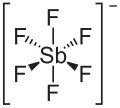4-Octyloxydiphenyliodoniumhexafluoroantimonat(V)
aus Wikipedia, der freien Enzyklopädie
| Strukturformel | ||||||||||||||||
|---|---|---|---|---|---|---|---|---|---|---|---|---|---|---|---|---|
 
| ||||||||||||||||
| Allgemeines | ||||||||||||||||
| Name | 4-Octyloxydiphenyliodoniumhexafluoroantimonat(V) | |||||||||||||||
| Andere Namen |
| |||||||||||||||
| Summenformel | C20H26IOSbF6 | |||||||||||||||
| Kurzbeschreibung |
gebrochen-weißer Feststoff[1] | |||||||||||||||
| Externe Identifikatoren/Datenbanken | ||||||||||||||||
| ||||||||||||||||
| Eigenschaften | ||||||||||||||||
| Molare Masse | 645,07 g·mol−1 | |||||||||||||||
| Aggregatzustand |
fest | |||||||||||||||
| Schmelzpunkt |
57 °C[2] | |||||||||||||||
| Sicherheitshinweise | ||||||||||||||||
| ||||||||||||||||
| Soweit möglich und gebräuchlich, werden SI-Einheiten verwendet. Wenn nicht anders vermerkt, gelten die angegebenen Daten bei Standardbedingungen. | ||||||||||||||||
4-Octyloxydiphenyliodoniumhexafluoroantimonat, C20H26IOSbF6 ist ein organisches Salz.
Verwendung
Als Photoinitiator kann ein Gemisch bestehend aus 4-Octyloxydiphenyliodoniumhexafluoroantimonat und 2,2-Dimethoxy-2-phenylacetophenon oder 2-Methoxy-2-phenylacetophenon verwendet werden. Dieses Gemisch wird für die Polymerisation einer Pyrrol-Methacrylat-Mischung eingesetzt, welches mit einer 365 nm LED bestrahlt wird.[3]
Eigenschaften
4-Octyloxydiphenyliodoniumhexafluoroantimonat ist ein gebrochen-weißer Feststoff. Sein Schmelzpunkt liegt bei 57 °C und der Flammpunkt bei 110 °C.[1][2]
Sicherheitshinweise
Die Verbindung ist toxisch bei Verschlucken oder Inhalieren.[2]
Einzelnachweise
- ↑ a b Datenblatt 4-Octyloxydiphenyliodoniumhexafluoroantimonate bei AlfaChemistry, abgerufen am 27. Februar 2019 (PDF).
- ↑ a b c d e Datenblatt p-(Octyloxyphenyl)phenyl iodonium hexafluoroantimonate bei abcr, abgerufen am 27. Februar 2019.
- ↑ Jacques Lalevée (Hrsg.), Jean-Pierre Fouassier (Hrsg.): Photopolymerisation Initiating Systems. Royal Society of Chemistry, 2018. ISBN 1-78801330-1, S. 37.

